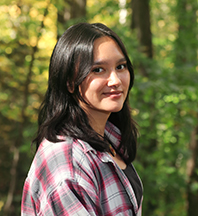Week of April 30, 2023 – May 6, 2023
by Sunny Guyette, Environmental Educator
Along many local roadways and trails, there is a leafy green plant emerging with heart-shaped leaves with toothed edges. Garlic Mustard or Alliaria petiolata is an invasive herbaceous, flowering plant that smells like garlic when crushed. The clustered white flowers bloom in May or June and only appear in the second year of the plant’s life. Garlic Mustard was brought over to North America from Europe during the 1800’s for medicinal purposes, and erosion control. Little did people know that Garlic Mustard would turn into one of our worst nightmares!
This plant is a threat to biodiversity and native plant species. It outcompetes native species by blocking their sunlight and taking up moisture and nutrients. Research has found that Garlic Mustard roots release chemical compounds that inhibit forest understory growth and even tree growth. Not to mention, seeds are spread by wind dispersal and each adult plant produces about 165 to 868 seeds a year. Once Garlic Mustard has established itself, it is there for the long run. But there are ways that you can help control this pesty plant!
The best way to get rid of Garlic Mustard is by pulling it up by hand before the seed pods ripen between mid July and October. First, learn to identify the plant. Then, if you see Garlic Mustard, uproot it and use it! Garlic mustard is a wild edible and has been historically used as a medicinal herb to induce sweating for colds and flus, to stimulate appetite and digestion, and it has been used as an expectorant and diuretic. But just like with any new wild edible, try a sample size of Garlic Mustard to ensure that you are not allergic to the plant.
One thing that I like to use Garlic Mustard for is to make pesto! Harvesting it while it is young offers a slightly less bitter taste. But like most relatives of the Mustard family, Garlic Mustard contains trace amounts of cyanide. While not enough to be deemed toxic to us, cooking it well will reduce the amount of cyanide if you plan on eating a large quantity.
Make sure you are positive that it is Garlic Mustard that you are removing, you wouldn’t want to accidentally pull up a native plant! Here are some resources of how to identify Garlic Mustard and how to remove it:
Want to get involved with combating invasive plants and restoring native habitats? Sign up for an upcoming stewardship work day at Baltimore Woods at Stewardship Work Days – Welcome to Baltimore Woods Nature Center | Nature in Your Hands


